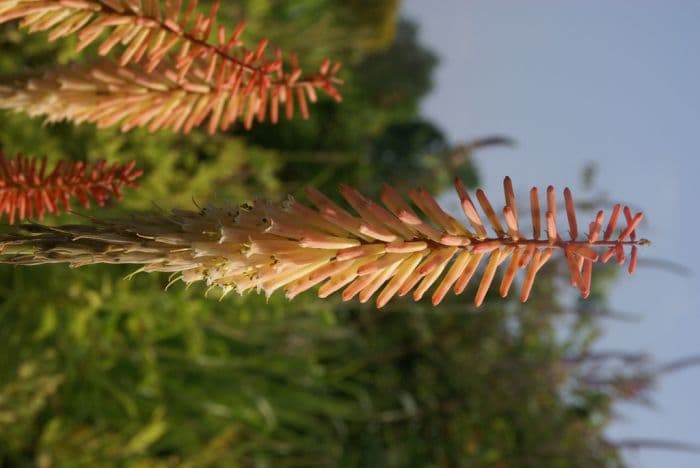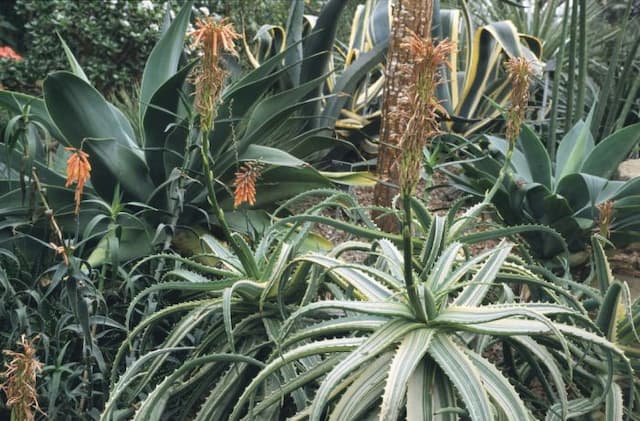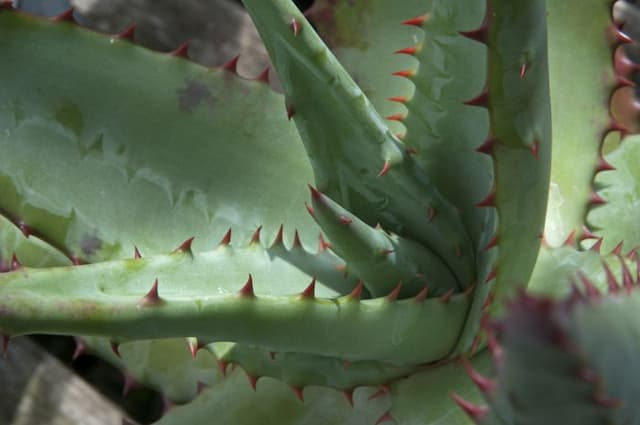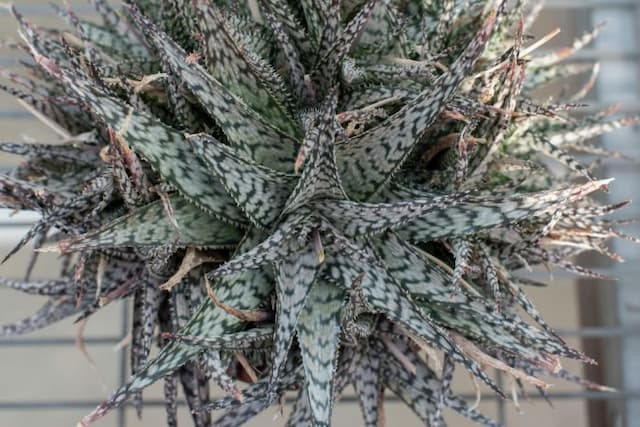Red Hot Poker Kniphofia 'Jenny Bloom'

ABOUT
Kniphofia 'Jenny Bloom', commonly known as Red Hot Poker or Torch Lily, is a striking perennial noted for its unique flowering spikes. This plant features a foliage clump of arching, narrow, grass-like leaves from which arise tall, sturdy stems topped with a cylindrical inflorescence reminiscent of a torch. The blossoms are a gradient of color, beginning with creamy-white buds that open into flowers of soft yellow that mature into a rich orange at the base. This creates a fiery display resembling a glowing poker or torch. The tubular flowers are neatly packed around the stem, forming a dense spike that adds vibrant color and an exotic look to the garden. These flower spikes are beloved by hummingbirds and other pollinators. The Red Hot Poker blooms during the summer months, and the flowers are long-lasting, making them an excellent choice for cut flower arrangements. The contrasting colors, along with the vertical interest they add to a garden scene, make the Red Hot Poker a sought-after plant for gardeners looking to add a touch of drama to their borders or flower beds.
About this plant
 Names
NamesFamily
Asphodelaceae
Synonyms
Red Hot Poker, Torch Lily, Tritoma
Common names
Kniphofia 'Jenny Bloom'.
 Toxicity
ToxicityTo humans
Red hot poker, including the cultivar Kniphofia 'Jenny Bloom', is not commonly known to be toxic to humans. In general, there is limited information on the plant's toxicity, and it is not typically considered a threat if touched or ingested in small amounts. However, as with any plant, individual reactions can vary, and it is always best to avoid ingesting parts of ornamental plants as a precaution.
To pets
Red hot poker, which includes the variety Kniphofia 'Jenny Bloom', is not typically listed as a poisonous plant for pets like cats and dogs. There is no widely recognized toxicity associated with this plant in animals. Nonetheless, ingestion of plant material can potentially lead to gastrointestinal upset due to the novelty and fibrous nature of the plant matter, so it's still advisable to prevent pets from consuming these plants.
 Characteristics
CharacteristicsLife cycle
Perennials
Foliage type
Evergreen
Color of leaves
Green
Flower color
Mixed
Height
2-3 feet (60-91 cm)
Spread
1-2 feet (30-61 cm)
Plant type
Herb
Hardiness zones
6
Native area
South Africa
Benefits
 General Benefits
General Benefits- Attracts pollinators such as bees and hummingbirds, which can improve the pollination of nearby plants.
- Provides vibrant color to the garden with its unique and eye-catching blooms.
- Drought tolerant once established, making it suitable for drier climates or water-conservative gardening.
- Works well in mixed borders or as a striking architectural plant due to its tall, spiky flowers and grass-like foliage.
- Low maintenance requirements, with little need for deadheading or frequent watering.
- Deer resistant, thus not likely to be damaged by grazing animals in areas where this is a concern.
- Can be used for cut flowers, offering long-lasting, unique flowers for bouquets and arrangements.
- Has a long blooming season, providing interest and color in the garden for an extended period.
- Perennial plant, meaning it will return year after year without the need for replanting.
 Medical Properties
Medical PropertiesThis plant is not used for medical purposes.
 Air-purifying Qualities
Air-purifying QualitiesThis plant is not specifically known for air purifying qualities.
 Other Uses
Other Uses- The tall, striking flowers of Kniphofia, commonly known as Red Hot Poker, can be used in dried floral arrangements, serving as an everlasting decoration with their vibrant colors and unique texture.
- When planted in mass groupings, Red Hot Poker can serve as a natural privacy screen due to its height and dense foliage, offering a visually appealing alternative to traditional fencing.
- The plant's ability to thrive in tough conditions makes it an excellent choice for erosion control on slopes, where its deep roots can help stabilize soil.
- Because of its height and structure, Red Hot Poker can be utilized as a living support for weaker, sprawling plants that might otherwise require a trellis or stakes.
- Red Hot Poker can act as a bold visual marker in the garden, helping to indicate the location of shorter plants that go dormant, so gardeners do not accidentally disturb them.
- As a plant that is resistant to deer browsing, Red Hot Poker can serve as a protective barrier around more vulnerable plants in the garden.
- The unique shape and vibrant colors of Red Hot Poker flowers can inspire artists and photographers, making it a visually compelling subject for creative works.
- In eco-friendly construction, the fibrous material from the foliage of Red Hot Poker may potentially be harvested as an insulating material or used in crafting.
- Red Hot Poker's tall, prominent blooms can be used to add vertical interest in container gardens, where their striking appearance can complement the arrangement.
- The dramatic appearance of Red Hot Poker can serve as a focal point in landscape design, drawing the eye and providing a central feature around which other plantings are organized.
Interesting Facts
 Feng Shui
Feng ShuiThe plant Kniphofia 'Jenny Bloom', also known as Red Hot Poker, is not used in Feng Shui practice.
 Zodiac Sign Compitability
Zodiac Sign CompitabilityThe plant Red Hot Poker is not used in astrology practice.
 Plant Symbolism
Plant Symbolism- Attention-Grabbing: The tall, vibrant flower spikes of the Red Hot Poker (Kniphofia 'Jenny Bloom') demand attention, symbolizing a call to awareness or the need to stand out in a crowd.
- Strength and Vitality: With its sturdy stems and tough, resilient nature, the Red Hot Poker often represents strength, good health, and vitality.
- Boldness and Courage: The striking appearance and fiery colors of the Red Hot Poker's blooms are commonly associated with a spirit of boldness and courage.
 Water
WaterRed Hot Poker plants, including the 'Jenny Bloom', generally need regular watering during their growing season, especially when they're establishing roots in the first season. Aim to water deeply once a week, providing about 1 to 1.5 gallons of water per plant. Ensure the soil is well-drained as they do not like to remain in soggy conditions. During hot, dry spells, increase watering to twice a week but reduce frequency once the plant is established and mature, as they are quite drought tolerant. Water the plant at the base to avoid wetting the foliage, which can lead to fungal diseases.
 Light
LightThe 'Jenny Bloom' Red Hot Poker thrives best in full sun conditions. It should be placed in a location where it can receive at least 6 to 8 hours of direct sunlight daily. These plants can tolerate some light shade, especially in hotter climates, but too much shade can result in fewer flowers and weaker growth.
 Temperature
Temperature'Jenny Bloom' Red Hot Poker is a hardy plant that can tolerate a wide range of temperatures. They can survive in temperatures as low as the mid-20s Fahrenheit, though frost may damage the foliage, and prefer a temperature range from 50°F to 85°F for optimal growth. It's ideal to plant them in an area where the temperature does not frequently drop below freezing.
 Pruning
PruningPruning 'Jenny Bloom' Red Hot Poker helps to maintain its attractive appearance and promote healthy growth. Deadhead the spent flower spikes throughout the bloom period to encourage more flowers. At the end of the growing season, usually in fall, cut back the foliage to a few inches above the ground. Pruning is typically done annually, or as needed to remove damaged or diseased plant material.
 Cleaning
CleaningAs needed
 Soil
SoilThe Red Hot Poker (Kniphofia 'Jenny Bloom') thrives best in well-draining, fertile soil with a slightly acidic to neutral pH between 6.0 and 7.0. A mix composed of loam, coarse sand, and peat or compost will provide the right balance of drainage and moisture retention. Regular amendment with organic matter will benefit the plant's growth and flowering.
 Repotting
RepottingRed Hot Pokers like Kniphofia 'Jenny Bloom' do not require frequent repotting as they prefer to be left undisturbed. They can be repotted or divided every 3-5 years to rejuvenate the plant and to manage its size.
 Humidity & Misting
Humidity & MistingRed Hot Pokers like Kniphofia 'Jenny Bloom' are tolerant of a range of humidity levels and do not have specific humidity requirements. They are well adapted to outdoor conditions and can thrive in the varying humidity levels commonly found in their hardiness zones.
 Suitable locations
Suitable locationsIndoor
Place in bright light, avoid overwatering, no special humidity needed.
Outdoor
Full sun, well-drained soil, drought-tolerant once established.
Hardiness zone
6-9 USDA
 Life cycle
Life cycleKniphofia 'Jenny Bloom', commonly known as Red Hot Poker, begins its life cycle with seed germination, typically in warm spring soil. The seedlings grow into juvenile plants with strappy leaves, developing a root system that is capable of surviving winter dormancy. As they mature in their second or third year, they form evergreen clumps of foliage and start to produce tall, striking flower spikes that tower above the leaves, with blooms that range from red to orange and cream. These flowers are pollinated by insects, particularly hummingbirds and bees, which facilitate the plant’s reproductive cycle. After pollination, seeds are produced and dispersed, sometimes self-sowing in ideal conditions. Throughout their lifespan, which can be several years, Red Hot Pokers may be divided and replanted to rejuvenate the clumps and promote more vigorous growth and flowering.
 Propogation
PropogationPropogation time
Early spring
Kniphofia 'Jenny Bloom', commonly known as Red Hot Poker, can be propagated by division which is the most popular method. This process is best done in the spring or early fall. To propagate by division, carefully lift the mature plant with a shovel, making sure to keep a good amount of root structure intact. Gently separate the plant into smaller sections, ensuring that each new section has a part of the crown and several root tendrils. Then, replant each division at the same depth it was growing previously and water it well to help establish the roots. It is important to give the divisions ample space to grow, as Red Hot Poker plants can spread out considerably as they mature.









